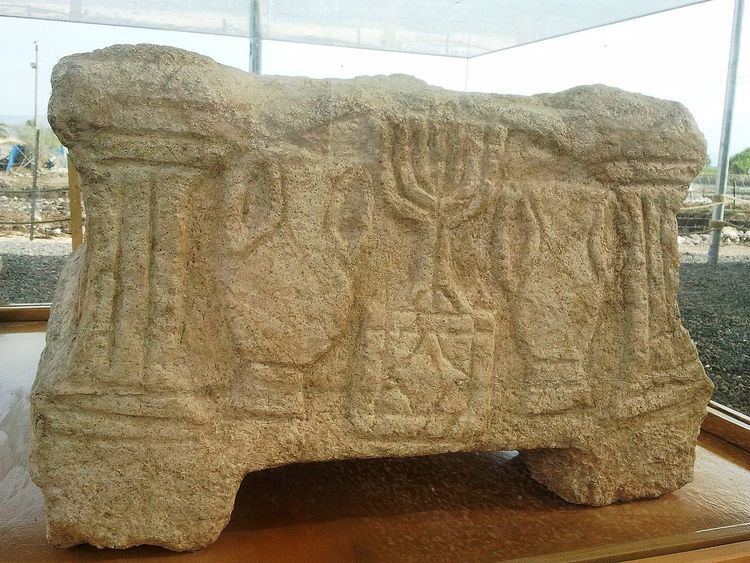 | ||
The Magdala stone is a carved stone block unearthed by archaeologists in a Galilean synagogue in Israel, dating to before the destruction of the Second Temple in Jerusalem in the year 70.
Contents
It is notable for detailed carvings depicting the Second Temple, carvings made while that Temple still stood and therefore assumed to have been made by an artist who had seen the Temple before it was destroyed by the Roman military. Some archaeologists describe the carvings as enabling a new, scholarly understanding of the synagogue conceptualized as a sacred space even during the period while the Temple was still standing. This new understanding would overturn a long-held scholarly consensus that during the period when the Temple still stood, synagogues were merely assembly and study halls, places where the Torah and other sacred books were read aloud and studied, but not sacred spaces in their own right.
The stone is also notable for having one of the earliest known images of the Temple Menorah.
History
The stone was uncovered during the 2009 excavation of the Migdal Synagogue.
Carvings
The stone is approximately 0.6 m. (24 in.) long, circa 0.5 m. (20 in.) wide and stands 0.4 m. (18 in.) high.
The facade of the stone, on the side that faces Jerusalem, features an arch supported by a pair of pillars. Within the arch a seven-branched menorah sits atop what appears to be a pedestal, flanked by a pair of two-handled jugs which may be sitting on some sort of stands. Dr. Avshalom-Gorni called the discovery "an exciting and unique find." This may be the oldest depiction of a menorah decoration and is the first menorah to be discovered in a Jewish context that dates to the Second Temple period and the beginning of the Early Roman era, the period when the Temple was still standing. "We can assume that the engraving that appears on the stone, which the Israel Antiquities Authority uncovered, was done by an artist who saw the seven-branched menorah with his own eyes in the Temple in Jerusalem".
However, Mordechai Aviam interprets the object beneath the menorah as an image of the Gold Altar (Inner Altar) that stood in front of the Menorah inside the ancient Temple.
The stone's side panels are identical; each shows an arcade of four arches. Interpretations of the carvings vary. While some have interpreted the sides as showing three arches filled with sheaves of grain (probably wheat), and a fourth with a hanging object thought to be an oil lamp, others, including Rina Talgam and Mordechai Aviam see it as an architectural image. According to Aviam it shows an arcade through which is seen a second arcade of arches which the viewer is meant to understand as the entrance arches of the Holy of Holies.
Placement in the synagogue at Migdal
The stone stood in the center of the Migdal Synagogue, and is tall enough to have been used as a reading desk or podium by someone in a seated position. A similar size stone was found in an ancient synagogue dating from the Byzantine period in a dig at nearby Horvat Kur; it is also carved with images of the Temple.
Rina Talgam, a professor specializing in the art of the ancient Near East at the Hebrew University of Jerusalem and the leading scholar of this stone, understands the Magdala Stone as a depiction of the Temple and the implements used in worship, including a depiction of the Holy of Holies by an artist who had actually seen the Temple and was familiar with the Holy of Holies. She understands the stone as intended to lend to this synagogue a sacred aura, making it, “like a lesser Temple”, for use in the Galilee, which was a long journey from Jerusalem under the conditions of that pedestrian era, when most people traveled by foot.
Other scholars of the period, including Elchanan Reiner, professor of Jewish history at Tel Aviv University, share her view.
Site
The original stone has been removed for safekeeping; a replica is displayed in the ancient synagogue at Migdal, now an archaeological site open to the public under the auspices of the Catholic Church.
